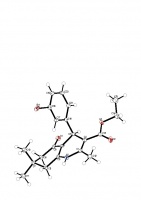 The effect of bromine scanning around the phenyl group of 4-phenylquinolone derivatives
The effect of bromine scanning around the phenyl group of 4-phenylquinolone derivatives The effect of bromine scanning around the phenyl group of 4-phenylquinolone derivatives
The effect of bromine scanning around the phenyl group of 4-phenylquinolone derivatives
Acta Crystallogr., Sect. C: Cryst. Struct. Commun. (2014), 70(8), 790-795, Steiger, Monacelli, Li, Hunting and Natale.
The crystal structures of three quinolone compounds were solved using Ithaca College’s single crystal X-ray diffractometer. The compounds were synthesized by our collaborators at the University of Montana.
Three quinolone compounds were synthesized and crystallized in an effort to study the structure-activity relationship of these calcium-channel antagonists. In all three quinolones, viz. Et 4-(4-bromophenyl)-2,7,7-trimethyl-5-oxo-1,4,5,6,7,8-hexahydroquinoline-3-carboxylate, (I), Et 4-(3-bromophenyl)-2,7,7-trimethyl-5-oxo-1,4,5,6,7,8-hexahydroquinoline-3-carboxylate, (II), and Et 4-(2-bromophenyl)-2,7,7-trimethyl-5-oxo-1,4,5,6,7,8-hexahydroquinoline-3-carboxylate, (III), all C21H24BrNO3, common structural features such as a flat boat conformation of the 1,4-dihydropyridine (1,4-DHP) ring, an envelope conformation of the fused cyclohexanone ring and a bromophenyl ring at the pseudo-axial position and orthogonal to the 1,4-DHP ring are retained. However, due to the different packing interactions in each compound, halogen bonds are observed in (I) and (III). Compound (III) crystallizes with two molecules in the asymmetric unit. All of the prepared derivatives satisfy the basic structural requirements to possess moderate activity as calcium-channel antagonists.
https://www.ithaca.edu/intercom/article.php/20141216131518717